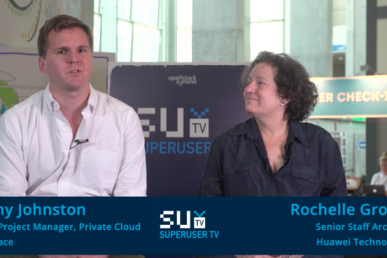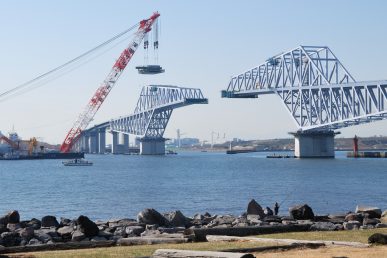_This post is part of the Women of OpenStack open mic series to spotlight women in various roles within our community, who have helped make OpenStack successful. With each post, we learn more about each woman’s involvement in the community and how they see the future of OpenStack taking shape. If you’re interested in being featured, please email [email protected]._
We’re featuring Rochelle Grober — or Rocky, as you know her from the Mid-Cycle meetups and Summits. A senior software architect at Huawei Technologies, Grober is active in the Product Working Group and on the DefCore committee.
At the upcoming Summit Tokyo, you can catch her at these talks.
She talked to Superuser about the danger of silos in OpenStack, when her work actually was rocket science and initiatives for women in tech that work.
What’s your role or (roles) in the OpenStack community?
Well, many people view me as an ambassador or evangelist, or liaison between various opinionated groups/individuals and OpenStack, but the best description for me may be “instigator.”
I don’t code much, if any, anymore, but I still review code, architect and find inconsistencies, holes, etc. I come from a background in hardware, systems and quality, and I’ve run service-oriented architectures (SOAs) and done third-line support, but my focus is really on quality, value and efficiency of OpenStack when in use.
You’re something of a Swiss army knife – you’re technical but practical, outspoken but diplomatic — how did you develop these skills?
I’m a generalist, a jack of all trades (I often say “and master of none!’) and in reality, a systems and process person. My degree is in electrical engineering (EE) which has a foundational approach of viewing any system or subsystem as a black box for which a model can be generated that replicates the input/output (I/O) of the black box’s I/O.
The EE background — of black boxes, feedback loops and systems — provides a perfect foundation for QA, operations, and root-sourcing problems. From there, I went on to be a hardware systems engineer, to modeling systems and telecommunications, to simulating systems and there I was in the middle of software design and implementation. But I always had the base of having to deal with real systems that aren’t perfect and do fail. So, I have the experience of tracking down failures and finding fixes. That’s who I am. I try to reduce/eliminate faults and when the occur, make them easy to diagnose, and improve all the -ilities.
What’s an interesting fact about you that people in the OpenStack community don’t know?
I analyzed the telecom connection on STS-3 and STS-4 during launch and presented recommendations on how to optimize the signal at the NASA retrospective.
or
I was lights and/or run crew for plays in college and community theater, and played in the orchestra for musical productions (violin, viola.)
There are always a lot of debates in the OpenStack community – which one is the most important, now?
Right now, the greatest need is breaking down the project silos. OpenStack is the product, and the projects are each components of that product. The projects need to come together to develop consistent formats, approaches and messaging across all the projects so that the users of this product can understand how to interact with and what to expect from the product, no matter which component (or project) is providing the interactions.
We’ve got a start on that, with the API standards working group, and now with the realization that projects have been building and releasing new versions of APIs but the other projects aren’t adopting them. The blinders are being removed (yay!). And along with this, is the realization that this cross project communication needs to be more than that, that it needs to be cross-functional. Devs have to talk to ops and app devs and vice versa to ensure that what the devs are designing and how they are implementing those designs actually address the needs of the user communities. And the user community needs to communicate how they are using the product(s) to the devs.
I would love to see a Summit presentation by a large system dev-ops team, walking through the process of realizing there is a problem, to tracking it down through monitors, logs and code, to the fix. I think it would be eye-opening for a lot of developers, and app developers; A ‘One firefight in the life of a dev-ops,’ if you will.
Finish the sentence: OpenStack is great for OpenStack is bad for.
OpenStack is great for small-to-midsize companies (OK, large, too, but it’s easier for them) who need the flexibility of cloud, either can’t afford to scale in Amazon Web Services (AWS) or can’t afford a costly commercial product and who have a person or team who can take the time to learn it, customize it and maintain it. If you’re big enough to spend one or two dev-ops’ salaries on AWS, you’re big enough to migrate to OpenStack in-house.
OpenStack is bad for people who will not commit the time and personnel to get their customization of a very complex infrastructure deployed, secured and maintained.
Unless you let some OpenStack company do it for you 😉
Why do you think it’s important for women to get involved with OpenStack?
I think it’s important to get all sorts of diversity injected into OpenStack. Not just women, but QA engineers, physicists (we have some from CERN!), chemists, Asians, Africans, etc.
Each group brings a different perspective to the table. With women, there is a higher level of interpersonal communication, cooperation and teamwork and planning things out before implementation.
Now, folks will say “I know a woman who isn’t…” or “I know some men who are….,” but the overall levels and styles of contribution shift more towards the characteristics I listed when women are a large enough presence to influence the process.
One of the experiences I will always remember is when a group of us (all engineers) bought a gas grill for a co-worker’s wedding. We got together the day before to put it together. The men just tore into assembly while the women sat down with the manual. The men constructed and tore the grill back down twice and the women finally stepped in to fix the grill to match the manual. 5+ hours total, with the women spending less than an hour hands-on the hardware.
What obstacles do you think women face getting involved in the OpenStack community?
There are quite a number of obstacles any newbie encounters trying to get started in OpenStack, but some that stand out to me for women are already turning up in the community.
Just look at the scheduled meeting the Women of OpenStack are having. They are doing voice conferences. Part of the reason for this is that IRC is hard for some of our members to access during the day, and part of it is the nature of the discussions, in that we are not discussing code implementations or algorithms, but I think that women are more comfortable and feel more accepted when conversations can also convey emotional content as voices do.
Women are much more sensitive to how they affect others and cue off audio or visual hints that help them steer a less volatile path to agreement. I think some of these qualities and ways of interacting also guide many more women to QA than you see with men. And, we all are aware that QA is a hard nut to crack in Open Source.
There are many efforts to get women involved in tech, what are some initiatives worked and why?
There are a couple I’ve helped with in the past. The Get SET program that works through college campuses and, at least out here, the Girl Scouts, provides a mini-conference for girls in grades 9-12 where girls are invited to participate in the conference and are allowed to select sessions they want to attend. The sessions are talks/demos/hands on sessions that women in technology put together especially for their intended audience. Multiple session run concurrently, just like the OpenStack Summit or an academic conference…The program runs two days and the final session has everyone together with a raffle of prizes donated by tech companies. When I worked with the program, I sat in on a session by a woman who went back to school in her early 40s, got a STEM degree and worked for United States Geological Survey (USGS). She talked about how much harder math was at 40 than when she was young and told an exciting story about meeting a bear coming up the other side of a hill while monitoring experiments in Alaska. Some schools brought in busloads of girls from one of the agricultural areas. I think it was quite fun and eye-opening for many of the girls.
Stanford runs a three-or four-day program where girls live in a dormitory and women in tech provide hands-on classes in fields of science. There are classes aimed at 6-8 grade and 9-12. One of the classes was building a waste water treatment system. Another used GPS equipment from Trimble (the presenter worked at Trimble) to do surveying and mapping in 3D. Again, pretty cool, but it’s hard to do this for a large group.
Anita Borg Institute and its programs, including the [Grace Hopper conference
Systers (http://anitaborg.org/get-involved/systers/), Code Chix (codechix.org), She’s Geeky (http://shesgeeky.org)
What publications, blogs, mailing lists, do you read every day?
openstack-dev + a bunch of other OpenStack lists
[email protected]
San Jose Mercury News,
Mother Jones (not every day, but enough…) (Daily Kos, environmental groups, yada yada)
Hmmm. Whatever turns up in my mailbox that leads me down the rabbit hole.
I wish I read faster. I’m an info junkie. I used to sit with our encyclopedia and start researching something when I was a kid (like the architecture of castles) and keep getting drawn into other stuff. Hyper links are kewl/evil/addicting.
Cover Photo // CC BY NC
- OpenStack Homebrew Club: Meet the sausage cloud - July 31, 2019
- Building a virtuous circle with open infrastructure: Inclusive, global, adaptable - July 30, 2019
- Using Istio’s Mixer for network request caching: What’s next - July 22, 2019

)










